Part 3 - Report on performance
Complaints overview
Complaints and approaches received
In 2015–16 the office received a total of 37 753 approaches (complaints and other approaches, such as requests for publications), compared to 28 154 in 2014–15, an increase of 34 per cent.
Of the total approaches received, 31 191 were in-jurisdiction complaints (compared to 20 940 in 2014–15). 56 per cent of the in-jurisdiction complaints related to the following agencies: the Department of Human Services (Centrelink 8702; Child Support 1452), Australia Post (5103) and the Department of Immigration and Border Protection (2341). Complaints received about Centrelink increased by 38 per cent over the previous year and comprised 27 per cent of all in-jurisdiction complaints received.
In 2015–16, the office received 93 complaints about agencies' handling of freedom of information applications, compared to 121 in 2014–15 (note: 2014–15 statistics represent the six months since FOI complaints came into the office's jurisdiction on 1 January 2015).
Most of the approaches the office receives are by telephone, and increasingly by electronic submissions. Table 1 below shows how this has changed over the past five years.
| Year | Telephone | Written | In Person | Electronic |
|---|---|---|---|---|
| 2015–16 | 58% | 3% | 1% | 38% |
| 2014–15 | 58% | 4% | 2% | 36% |
| 2013–14 | 56% | 5% | 3% | 36% |
| 2012–13 | 57% | 6% | 2% | 35% |
| 2011–12 | 70% | 5% | 2% | 23% |
Complaint-handling
In 2015–16 the office finalised 31 209 in-jurisdiction complaints, 48 per cent more than in 2014–15. Most of these (90 per cent) were finalised without having to commence an investigation. This was due to the office's practice of encouraging complainants to first approach the agency concerned. Furthermore, where appropriate, some key agencies are encouraged to resolve complaints without the office needing to become involved.
Of the complaints the office investigated, 19 per cent required more substantial investigation (categories four and five in the office's five-category complaint system). This is slightly less than in 2014–15 (24 per cent).
Reviews
The office has a formal non-statutory review process for complainants who are dissatisfied with the conclusions reached by the office.
As a first step, where a complainant indicates dissatisfaction with a decision, the investigation officer will reconsider the decision. A complainant who remains dissatisfied may request a review by an officer not previously involved in the matter.
In 2015–16, the office received 104 requests for review, compared to 154 in 2014–15.
Of these, the office declined 20 requests, affirmed the original investigation decision in 79 reviews, and further investigated 23 complaints. In three of these cases the office changed the earlier decision. (One request for review was withdrawn by the complainant).
The reason why the office declined to reconsider 20 decisions was that there was no reasonable prospect of getting a better outcome for the complainant. It is worth noting that some complainants provide no reason for a review other than that they disagree with the investigation officer's decision.
Annual Performance Statement
As required under paragraph 39(1) of the Public Governance, Performance and Accountability Act 2013 the office has prepared its 2015–16 Annual Performance Statement, which accurately reflects its performance during the 2015–16 reporting period.
The office's Annual Performance Statement provides information and analysis on the office's performance in achieving its purpose by reporting overall outcomes against each Key Performance Indicator (KPI) established in the 2015–16 Corporate Plan and Portfolio Budget Statement. Table 2 shows how the office met six of nine KPIs during the financial year, which demonstrates its ability to carry out its purpose effectively.
As per the analysis section of Annual Performance Statement, the office achieved these results under increasing work volumes with constrained resources. Despite the challenging environment, significant investment has been made in stakeholder engagement activities to enhance the office's position as an oversight body and driver of public administration improvement in Australia and the region.
Throughout the year, the office considered how the KPIs could be improved. Consequently, following extensive consultation, the office has further refined its KPIs. They will be incorporated in the office's 2016–17 Corporate Plan.
Overall, the office was successful in achieving its objectives for the 2015–16 financial year.
Statement of Preparation
I, as the accountable authority of the Office of the Commonwealth Ombudsman (the office), present the 2015–16 Annual Performance Statement of the office, as required under paragraph 39(1)(a) of the Public Governance, Performance and Accountability Act 2013 (the PGPA Act). In my opinion, this Annual Performance Statement is based on properly maintained records, accurately reflects the performance of the entity, and complies with subsection 39(2) of the PGPA Act.
Colin Neave

Commonwealth Ombudsman
Purpose Statement
The office is a non-corporate Commonwealth entity established by the Ombudsman Act 1976 (the Ombudsman Act) and is subject to the PGPA Act.
Our purpose is to:
- provide assurance that the organisations we oversight act with integrity and treat people fairly
- influence systemic improvement in public administration in Australia and the region.
Outcome
The office's outcome as described in its Portfolio Budget Statement for 2015–16 is:
"Fair and accountable administrative action by Australian Government entities and prescribed private sector organisations, by investigating complaints, reviewing administrative action and statutory compliance inspections and reporting."
The office established nine KPIs that will enable measurement of performance in achieving this outcome. The results and subsequent analysis of performance are presented within this document.
KPI 1—Percentage of systemic issue recommendations accepted by entities
One of the major functions of the office is to identify and report on systemic issues in public administration. As a measure of its success in influencing entities to improve the administration of their programs and complaint-handling systems, the office measures the adoption of its systemic issue recommendations.
The office's result for KPI 1 is 81.25 per cent.
Data sources for this result were the office's public investigation reports and other formal reports and letters issued during 2015–16.
Methodology
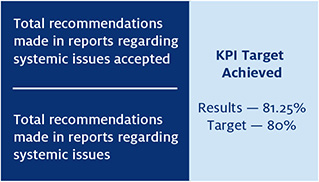
The office submitted three reports to the Department of Human Services (DHS) and the Australian Securities and Investments Commission (ASIC) during 2015–16. Sixteen systemic recommendations were made across the reports, of which 13 were accepted or partially accepted.
KPI 2—Stakeholders participating in engagement activities are satisfied
Another method that the office uses to achieve its first strategic objective is through regular stakeholder engagement. These engagement sessions are an enabler for improved Australian public administration through collaboration with agency, private sector and community stakeholders.
The office's result for KPI 2 is 96 per cent.
The office measured the feedback from participants at stakeholder engagement activities (including stakeholder forums and communities of practice). This included post-event online surveys and evaluation forms completed by hand.
Methodology
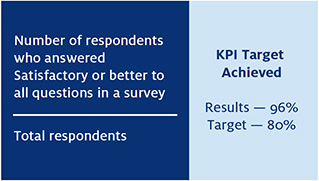
The office measured feedback from participants at seven stakeholder engagement activities held by the Social Services Team during 2015–16. Feedback was provided via handwritten responses to survey questions and post-event online surveys. A total of 124 stakeholders provided feedback following the sessions, of which five responded that they were less than satisfied to at least one question asked.
KPI 3(a)—Office obligations under Australian Aid arrangements are met (outputs delivered)
The office provides assistance to a range of regional partners consistent with Australian Aid priorities through the Department of Foreign Affairs and Trade (DFAT). Regional Ombudsmen partners include: Indonesia, Solomon Islands, Papua New Guinea, and other Pacific nations under the Pacific Ombudsman Alliance.
Data sources used to calculate the results were reviews of grant assessments and related correspondence.
Methodology
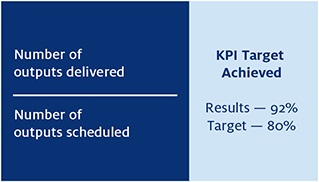
The office is required to carry out scheduled activities each year in order to comply with obligations under Australian Aid arrangements with DFAT.
KPI 3(b)—Office obligations under Australian Aid arrangements are met (reporting obligations)
The continuing success of the office administering its Australian Aid arrangements is contingent on strictly meeting DFAT reporting requirements for grant agreements.
Methodology
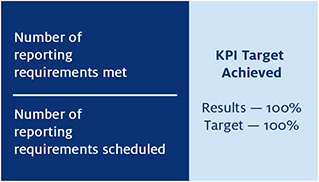
All reporting requirements for DFAT were met during 2015–16.
KPI 4—Percentage of complaints finalised within the office's service standards
Receiving and investigating complaints/approaches is an important function of the office as it enables the public to challenge (and seek independent review of) the actions of the entities the office oversights.
The majority of complaints are handled by two areas in the office—the Operations Branch and Private Health Insurance Team. A comparatively small number of complaints are handled by the Social Services, Indigenous and Public Interest Disclosure, and Immigration and Overseas Students Teams.
The office measures timeliness of complaint handling services based on the category of approaches received. Approaches can be assigned to one of five Categories based on the complexity of the issue, with Category 1 being the least complex, and Category 5 being the most complex. The service standard timeframe for each Category is consistent throughout the office as follows:
| Approach Category | To be finalised within |
|---|---|
| Category 1 | 3 working days |
| Category 2 | 2 weeks |
| Category 3 | 3 months |
| Category 4 | 6 months |
| Category 5* | 12 months |
*Private Health Insurance do not handle Category 5 complaints
Methodology
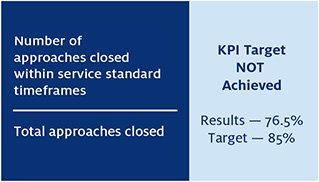
Results by Category
Taking the varied timeframes into account, the following results were calculated for whole-of-office during 2015–16:
| Approach category | Approaches closed | Approaches closed within timeframe | Percentage finalised within timeframe |
|---|---|---|---|
| Category 1 | 13 708 | 11 851 | 86.5% |
| Category 2 | 15 484 | 10 386 | 67.1% |
| Category 3 | 2364 | 1942 | 82.1% |
| Category 4 | 566 | 398 | 70.3% |
| Category 5 | 9 | 2 | 22.2% |
| Total | 32 131 | 24 579 | 76.5% |
KPI 5—Percentage of statutory requirements met
In providing effective oversight of entities' compliance with legislation and policy in the use of selected intrusive or coercive powers, the office has a range of statutory requirements in relation to law enforcement and immigration detention.
Methodology
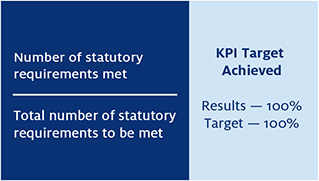
The office has statutory obligations to carry out inspection regimes on relevant agencies, and meet reporting requirements following those inspections.
KPI 6—Percentage of recommendations accepted by entities
In providing effective oversight of entities' and prescribed private sector organisations' compliance with legislation and policy in the use of selected intrusive or coercive powers, the office identifies and reports on compliance and provides recommendations to these entities.
Data sources were records, Law enforcement report recommendations, Immigration report compliance and Immigration Detention inspections (excluding s 486O reports).
Methodology
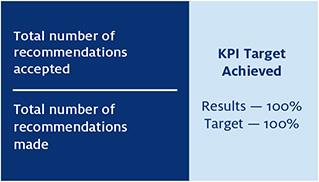
All recommendations made by the office were accepted. The office adopts an approach of consultation with agencies in order to achieve high acceptance rates when making recommendations.
KPI 7—Percentage of statutory requirements met
In providing effective oversight and promotion of the administration of the Public Interest Disclosure scheme for the Commonwealth public sector, the office has a range of statutory requirements. These include legislation, records and internal standards.
Methodology
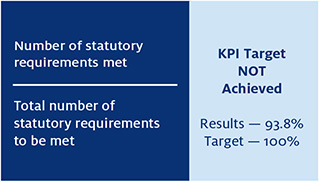
The extent to which the office met its statutory requirements in relation to the PID scheme was measured by analysis of the timeliness of allocation decisions made. Under the Public Interest Disclosure Act 2013, an authorised officer must use best endeavours to make an allocation decision within 14 days of receipt of a disclosure. Over the course of the year, authorised officers assessed 65 internal PIDs, of which 61 were allocated within 14 days, while four allocation decisions were delayed.
KPI 8—Stakeholders participating in engagement activities are satisfied
The office conducts regular stakeholder engagement and guidance in an endeavour to: ensure that its statutory requirements in relation to PIDs are met; and raise awareness and assist entities with the proper implementation of PID within the public sector.
Methodology
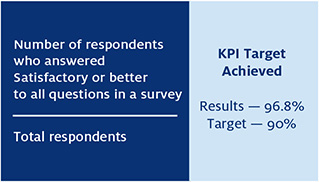
The office measured the feedback from participants at 26 PID-related stakeholder engagement activities (including stakeholder forums and communities of practice). Feedback was provided via post-event online surveys. A total of 285 stakeholders provided feedback following these sessions, of which nine indicated they were less than satisfied in at least one question asked. The responses available to respondents were Excellent, Very Good, Good, Satisfactory and Poor.
KPI 9—Reliable information is provided to consumers via the private health insurance consumer website
Methodology

The office gauged consumer satisfaction with the private health insurance consumer website via online surveys submitted by users throughout 2015–16. The number of respondents who found the quality of information provided on the website to be Very Good or Satisfactory was 525 out of a total of 699 responses.
The key area of concern was the functionality of the PrivateHealth.gov.au website, which is currently being updated.
Overall analysis of office performance
By meeting six of nine KPIs established for the 2015–16 financial year, the office has demonstrated its ability to carry out its purpose effectively throughout the year.
With respect to complaint-handling, the office is currently operating in an environment of constrained resources and increasing work volume. A total of 37 753 approaches were received during 2015–16, compared to 28 154 approaches in 2014–15. This is an increase of 34 per cent, while the increase from 2013–14 to 2014–15 was 20 per cent. Additionally, delays in receiving responses from the Department of Human Services and the Department of Immigration and Border Protection, both of which constitute a significant proportion of complaints received about agencies, has hampered the office's ability to meet the service standard target. Nevertheless, the office is endeavouring to improve service standards by reducing timeframes for closing of approaches. A key strategy in place for improving performance during 2016–17 is to improve the responsiveness of agencies to our investigations as well as seeking to reduce staff turnover and consequent loss of expertise.
The office invested heavily in stakeholder engagement activities throughout the year to provide robust oversight and influence systemic improvement in public administration in Australia and the region.
Office results
The table below presents the office's performance against each of its 2015–16 Key Performance Indicators (KPIs) and how each KPI relates to the office's strategic objectives, deliverables and anticipated targets.
| Strategic Objectives | Key Deliverables | Key Performance Indicators for 2015–16 | Target | Result |
|---|---|---|---|---|
| Objective 1 Influence Australian Government entities, prescribed private sector organisations and our regional partners, to improve the administration of their programmes and complaint-handling systems | Identifying and reporting on systemic issues in public administration, including making recommendations | KPI 1 Percentage of systemic issue recommendations accepted by entities | 80% | 81.25% |
| Influencing Australian Government entities, prescribed private sector organisations and our regional partners to improve complaint-handling systems and administration of programs through stakeholder engagement and guidance | KPI 2 Stakeholders participating in engagement activities are satisfied | 90% | 96% | |
| Assistance to regional partners consistent with the Australian Aid priorities | KPI 3(a) Office obligations under Australian Aid arrangements are met (outputs delivered) | 80% | 92% | |
| KPI 3(b) Office obligations under Australian Aid arrangements are met (reporting obligations) | 100% | 100% | ||
| Objective 1 Provide an efficient and effective complaint-handling service | Ensuring the office's complaint-handling service is delivered within its service standards | KPI 4 Percentage of complaints finalised within the office's service standards | 85% | 76.5% |
| Objective 2 Provide effective oversight of entities and prescribed private sector organisations compliance with legislation and policy in the use of selected intrusive or coercive powers | Office statutory requirements in relation to oversight of entities and prescribed private sector organisations compliance with legislation and policy in the use of selected intrusive or coercive powers are met | KPI 5 Percentage of statutory requirements met | 100% | 100% |
| Objective 3 Provide effective oversight of entities and prescribed private sector organisations compliance with legislation and policy in the use of selected intrusive or coercive powers | Inspecting and reporting on entity and private sector organisation compliance with accountability principles and policy requirements | KPI 6 Percentage of recommendations accepted by entities | 80% | 100% |
| Objective 4 Provide effective oversight and promotion of the administration of the Public Interest Disclosure scheme for the Commonwealth public sector | Office statutory requirements in relation to Commonwealth PIDs are met | KPI 7 Percentage of statutory requirements met | 100% | 93.8% |
| KPI 8 Stakeholders participating in engagement activities are satisfied | 90% | 96.8% | ||
| Objective 5 Provide quality and accessible private health insurance information | Providing consumers with accurate and up-to-date private health insurance information | KPI 9 Reliable information is provided to consumers via the private health insurance consumer website | 80% | 75.1% |
Financial performance
In 2015–16 the office recorded an operating deficit of $0.079 million (excluding depreciation and amortisation). In 2014–15 the operating deficit was $0.002 million.
The deficit was caused mainly by revenue of $0.100m that was not provided by Fair Work Building and Construction for reviews of the exercise of powers under Division 3 (Examination Notices) under s 54A(3) of the Fair Work (Building Industry) Act 2012. If this revenue had been received, the office would have achieved a balanced operating result consistent with the 2015–16 Portfolio Budget Statements.
Expenses
Total expenses increased from $21.7 million in 2014–15 to $24.4 million in 2015–16. The increase was mainly due to costs associated with the Private Health Insurance Ombudsman (PHIO) function, which was transferred to the office on 1 July 2015, and the work associated with the new data retention oversight function under the Telecommunications (Interception and Access) Amendment (Data Retention) Act 2015. Costs for the International Program also increased.
Income
Appropriation revenue increased from $18.4 million in 2014–15 to $20.8 million in 2015–16, an increase of $2.4 million. The $2.4 million included $1.8 million for the new data retention oversight function, and $2.1 million for the PHIO function. These increases were offset by the $0.5 million funding transfer for the tax complaints function to the Inspector-General of Taxation; $0.7 million reduction from 2014–15 for profiling and restructuring and a further $0.4 million reduction for efficiency dividends and other savings measures.
Sale of goods and rendering of services revenue stayed consistent, the majority of this income comes from the International Program funded by the Department of Foreign Affairs and Trade, and the work undertaken for the ACT Ombudsman which is funded by the ACT Government.
Assets
Total assets increased by $0.482 million, mainly comprising:
- asset purchases: $0.864 million
- acquisition of assets through restructure: $0.494 million
- an asset revaluation increment: $0.121 million
- offset by depreciation and amortisation: $0.894 million and a decrease in financial assets of $0.074 million.
The $0.864 million in new assets acquired by the office in 2015–16 was funded through the Departmental Capital Budget. It included the replacement of Information and Communications Technology (ICT) infrastructure, purchase of new software, refurbishment of offices and enhancements to existing ICT systems. The office also acquired $0.494 million in assets through the transfer of the Private Health Insurance Ombudsman function. This included $0.067 million in infrastructure and $0.427 million in intangibles (PrivateHealth.gov.au website).
Liabilities
Total liabilities decreased by $0.587 million, which was mainly due to decreased payables for salaries ($1.184 million), offset by an increase in provisions of $0.597 million. The increase in provisions was a result of the movement in employee provisions due to the lower bond rate ($0.548 million) and a revision of the estimated costs for 'make good', for the office's property leases following a property revaluation ($0.050 million).
